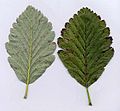
Viburnum lentago, the nannyberry, sheepberry, or sweet viburnum, is a species of Viburnum native to North America.

Sorbus is a genus of over 100 species of trees and shrubs in the rose family, Rosaceae. Species of Sorbus (s.l.) are commonly known as whitebeam, rowan, mountain-ash and service tree. The exact number of species is disputed depending on the circumscription of the genus, and also due to the number of apomictic microspecies, which some treat as distinct species, but others group in a smaller number of variable species. Recent treatments classify Sorbus in a narrower sense to include only the pinnate leaved species of subgenus Sorbus, raising several of the other subgenera to generic rank.

Chamaemespilus is a genus of shrubs in the family Rosaceae. It is monotypic, being represented by the single species Chamaemespilus alpina, commonly known as false medlar or dwarf whitebeam. It is native to the mountains of central and southern Europe, from the Pyrenees east through the Alps to the Carpathians and the Balkans, growing at elevations of up to 2500 m.

Carpinus caroliniana, the American hornbeam, is a small hardwood understory tree in the genus Carpinus. American hornbeam is also known as blue-beech, ironwood, musclewood and muscle beech. It is native to eastern North America, from Minnesota and southern Ontario east to Maine, and south to eastern Texas and northern Florida. It also grows in Canada. It occurs naturally in shaded areas with moist soil, particularly near the banks of streams or rivers, and is often a natural constituent understory species of the riverine and maritime forests of eastern temperate North America.

Acer ginnala, the Amur maple, is a plant species with woody stems native to northeastern Asia from easternmost Mongolia east to Korea and Japan, and north to the Russian Far East in the Amur River valley. It is a small maple with deciduous leaves that is sometimes grown as a garden subject or boulevard tree.

Karpatiosorbus latifolia is a species of whitebeam that is endemic to the area around Fontainebleau, south of Paris in France, where it has been known since the early eighteenth century.

Acer shirasawanum, the Shirasawa maple or fullmoon maple, is a species of maple native to Japan, on central and southern Honshū, Shikoku, and Kyūshū.
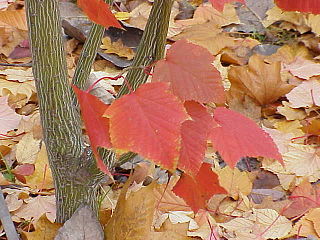
Acer capillipes, is a maple in the same taxonomic section as other snakebark maples such as A. pensylvanicum, A. davidii and A. rufinerve. It is native to mountainous regions in Japan, on central and southern Honshū, Kyūshū and Shikoku islands, usually growing alongside mountain streams.
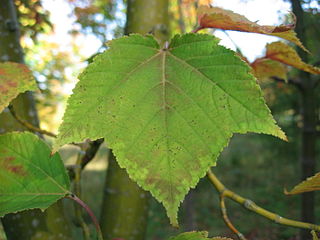
Acer rufinerve, the grey-budded snake-bark-maple, redvein maple or Honshū maple, is a species of tree in the snakebark maple group, related to Acer capillipes. It is native to mountain forests of Japan, on Honshū, Kyūshū and Shikoku.
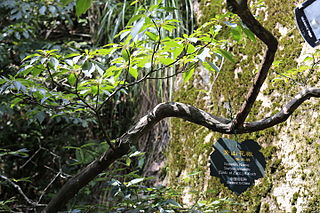
Sorbus commixta, the Japanese rowan, is a species of flowering plant in the family Rosaceae, native to central and eastern China, Korea, Japan, and Sakhalin.
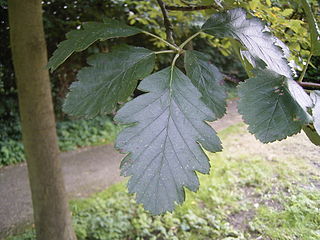
Scandosorbus intermedia or, formerly, Sorbus intermedia, the Swedish whitebeam, is a species of whitebeam found in southern Sweden, with scattered occurrences in Estonia, Latvia, easternmost Denmark (Bornholm), the far southwest of Finland, and northern Poland.

Hedlundia hybrida, the Swedish service-treeFinnish whitebeam, or oakleaf mountain ash, is a species of whitebeam native to Norway, eastern Sweden, south-western Finland, and locally in Latvia.

Alniaria alnifolia, also called alder-leafed whitebeam, Korean whitebeam, or Korean mountain ash, Korean: 팥배나무; RR: Patbaenamu; MR: p'atpaenamu; lit. 'red bean pear tree' Chinese: 水榆花楸; pinyin: shui yu hua qiu; lit. 'water elm rowan', is a species of whitebeam native to eastern Asia in eastern and northern China, Taiwan, Korea and Japan.

Sorbus hupehensis, also known as Hupeh rowan or Hubei rowan, is a species of rowan native to central and western China. It is found between Qinghai and Gansu in the west, Yunnan in the south, Jiangxi in the southeast, and Shandong in the east.

Sorbus sargentiana, commonly known as Sargent's rowan is a species of flowering plant in the family Rosaceae. It is native to southwestern Sichuan and northern Yunnan in China, where it grows at altitudes of 2,000–3,200 m (6,560–10,500 ft).

Karpatiosorbus devoniensis is known by the English name of Devon whitebeam and formally as Broad-leaved Whitebeam. When the fruit was reported as sold at Barnstaple Pannier Market the name French Eagles was used, apart from 1929 when they were reported as eagle-berries. When the trees were reported as seen growing wild on botanical walks they were referred to as French Hails. Broad-leaved white-beam, which was the common name until Devon Whitebeam took over, was used once in 1907.

Hedlundia thuringiaca is a widely cultivated species of ornamental shrub. It is cultivated by grafting.
Karpatiosorbus houstoniae, or Houston's whitebeam, is a hybrid of two deciduous trees: the common whitebeam and the Bristol whitebeam. Only a single example of the hybrid is known to exist, at the Avon Gorge in Bristol, England. The only specimen grows on a cliff below Stokeleigh Camp at Leigh Woods in North Somerset and cannot be accessed without ropes.

Euclea crispa, commonly known as the blue guarri, is an Afrotropical plant species of the family Ebenaceae. The hardy and evergreen plants may form a dense stand of shrubs, or grow to tree size. It is widespread and common in the interior regions of southern Africa, and occurs northward to the tropics. Though some are present near the South African south and east coasts, they generally occur at middle to high altitudes. It is readily recognizable from its much-branched structure and dull bluish foliage colour. Those bearing lanceolate leaves may however resemble the Wild olive, another common species of the interior plateaus.

Torminalis is a genus of plants in the rose family Rosaceae. The genus Torminalis was formerly included within the genus Sorbus, as the section Torminaria, but the simple-leafed species traditionally classified in Sorbus are now considered to form a separate monophyletic group. It is monotypic, being represented by the single species, Torminalis glaberrima, commonly known as wild service tree, chequers, and checker tree. This tree is native to Europe, parts of northern Africa and western Asia.


